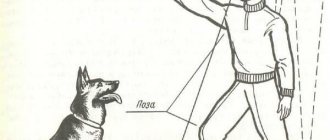Teaching your pet commands is a component of the educational process. Training is needed to instill discipline skills in your four-legged friend. A well-mannered dog is the pride and safety of its owner. With a disciplined pet, you will be protected from possible problems during walks, from disorder in the house, chewed slippers, unexpected barking, frightened passers-by and other troubles. Therefore, you need to teach your puppy commands as soon as possible - dog experts recommend starting classes at three months of age.
Why do you need to train a dog?
The set of commands for non-service dogs can be very diverse. Some owners ask their four-legged friend to bring slippers, others command “Guard!”, and still others teach the pet to bow. Dogs are highly trainable and can learn a wide range of skills.
Of course, the first need for learning commands is education. The dog must understand the prohibition and perform the simplest actions so that the whole family can live comfortably with their four-legged pet.
The second most important reason is discipline. When training, the dog is placed one step lower than the person and understands that she is not a leader. This forms obedient, but at the same time respectful behavior of the animal.
The third reason is that if a dog was bred for specific purposes (watchman, guide, companion, hunter), it must be able to carry out specific commands. They are usually learned under the guidance of an experienced trainer.
Additional, so to speak, bonus benefits include having fun together between the owner and the four-legged dog. Both learn to understand and respect each other, a rapprochement occurs and a strong friendship develops.
The role of proper education
To raise a pet correctly, it is important to understand the peculiarities of canine psychology: every dog sees a pack in his family, so the owner’s duty is to show himself as a strong and confident leader from the first day of the puppy’s presence in the house, otherwise your pet will take this place (at least in his family). presentation). The consequence of this position of the animal is disobedience and excessive aggression.
The dog must be trained in basic skills and natural needs (regular walks, toilet, sleep). However, this will not be achieved without mastering the simplest commands. To make raising an ideal pet possible, you will have to show strength of character and not back down until you achieve unquestioning obedience.
How to teach a dog commands: on your own or with a trainer?
Despite the fact that a dog is considered man's best friend, possessing extraordinary intelligence, initially any puppy is a cute, naughty creature. He has a habit of doing what he pleases, without regard to the wishes and requests of his master. Teaching your puppy commands at home should begin as early as possible. The ideal age for learning the first commands is 2-3 months. At this time, the puppy may well master the simplest skills.
Raising an obedient animal is a long, labor-intensive process that requires patience and endurance. Not every owner can do this, so inexperienced dog breeders often turn to an instructor. But, if you do not plan to take your four-legged friend to exhibitions or you have a decorative breed, you can do training at home.
Homeschooling has many advantages:
- the animal exercises in a familiar environment without experiencing stress;
- the dog learns to listen to its owner;
- saving travel time;
- financial savings.
- Disadvantages of self-training:
- takes longer;
- the effectiveness of training for inexperienced breeders is lower (especially if the breed is difficult to train);
- limited types of services and commands that can be taught to a dog;
- There remains the possibility of mistakes on the part of the owner, which can lead to the consolidation of unwanted skills in the dog.
If you decide to train your pet yourself, be prepared to be strict. For correct, successful execution of commands, you need to praise the dog, and for non-compliance, show your dissatisfaction. Animals pick up intonations very well, so it’s enough to express your disappointment with your voice.
If you have no experience in dog breeding or you have a breed that requires strict training, it is advisable to seek advice from an instructor. He will tell you how to teach your dog commands at home, taking into account its character, temperament and breed. It is not necessary for the dog to be purebred - mongrels also need good upbringing.
Pros of training an animal with a trainer:
- saving your time and effort;
- upon completion of the courses, a certificate is issued - it can be useful at exhibitions and competitions;
- regularity of classes;
- professional approach - the result will be achieved in any case.
Of the minuses:
- the dog gets used to the conditions of the school and to the trainer - the owner will have to make efforts so that its skills are transferred to everyday life;
- stress for the dog, especially for the puppy;
- Instructor services are not that cheap.
Each owner decides for himself whether to turn to a trainer or train the dog on his own. In both cases, the dog breeder will have to take the issue seriously and take responsibility.
Another important point in training is the owner’s self-discipline. Without it, raising an obedient dog is almost impossible - the owner needs to work not only on raising the animal, but also on himself. If you feel a lack of rigor and consistency, it is better to contact a professional trainer.
Common Mistakes
Not all dogs can be trained to follow the “Voice” command. Some breeds are simply not trainable, such as most hunting dogs. In addition, excessive pressure on the dog can negatively affect his psyche - cause aggression or even illness. If you are unable to train your dog on your own, it is recommended that you contact a professional.
During the training process, it is strictly contraindicated to punish or beat the dog. This can only spoil her character and make her very aggressive. All commands must be pronounced in a calm, even and clear voice, and no anger or dissatisfaction should be heard in the sound of the voice.
Whatever training option is used, we must not forget that a dog is a living, intelligent creature. The dog will happily follow any command if the owner treats him well and with respect.
What training courses are there?
If you decide to use the services of a professional dog trainer, your next step is to choose a training program. There are several types of training courses. Each course not only determines how to teach a dog certain commands, but also solves a number of additional problems.
OKD
This is a general training course (abbreviated as OKD), which includes basic commands for dogs, which can be taught to a pet of any breed - from a shepherd to a toy terrier.
The skills and abilities acquired in this course form the basis for the formation of conditioned reflexes in an animal.
After completing the OKD, your dog will learn:
- walk next to the trainer/owner;
- wear a muzzle;
- do not pick up anything from the ground;
- understand the prohibiting command;
- listen to commands: landing, laying, standing;
- execute the “Aport” command;
- know your place;
- respond to a call;
- overcome obstacles;
- do not respond to noise stimuli.
The duration of general training courses is 2-4 months, classes are held 1-2 times a week.
UGS
This course is suitable for those who are faced with the following problems:
- the dog does not obey when walking, does not want to walk on a leash, and if you let it go, it constantly runs away;
- barks and jumps on passers-by, cyclists, runners;
- picks up trash on the street;
- behaves aggressively towards other animals;
- is terrified of city noise.
The goal of the UGS (manageable city dog) course is not only to teach the animal adequate behavior in urban conditions, but also to show the owner how to manage the pet in everyday life. The course is designed for dog lovers who want a simple, comfortable and easy-to-handle companion dog.
UGS is in many ways reminiscent of OKD, and only an experienced dog handler will be able to see the fundamental difference between one course and another. The UGS exam includes a test of only 8 skills that are necessary for a comfortable life for a person and a dog in a big city. These skills include:
- calm attitude to city noise;
- lack of fear of traveling in transport;
- friendly and peaceful attitude towards strangers and animals;
- obedience on walks and at home;
- knowledge of the "Fu" command.
OKD is the basis for mastering more complex courses: protective guard, service, etc.
ZKS
The Protective Guard Service (PSS) is aimed at developing security and defensive skills in your pet. The course was developed in the middle of the 20th century in the USSR. Basically, such training is designed for the training of security, guard, escort, and patrol dogs. However, the course is in great demand among amateur dog breeders: it helps to raise a guard dog.
It is important to know that this training course cannot be completed on your own. To successfully pass the exam, training is required exclusively with an experienced dog handler and instructor. In addition, to complete the course, your dog must meet a number of requirements:
- age at least one year;
- the dog must have a strong nervous system and a stable psyche;
- good sense of smell and hearing, no problems with teeth and jaw;
- the dog must know the OKD course;
- have muscles, be physically developed.
The most suitable breeds for ZKS are German, South Russian, Caucasian, Central Asian Shepherd Dogs, Doberman Pinschers, Rottweilers, Black Terriers, and Moscow Watchdogs.
Service and rescue
Search and rescue is considered one of the most difficult of all training courses. The rescue dog certification program includes a set of obedience and agility tests.
The exam tests the following skills:
- sampling things by smell;
- searching for the victim's belongings;
- search for the victim;
- giving voice;
- digging up a thing or person.
Search and rescue dogs must meet the following criteria: be completely healthy and physically resilient, have an ideal sense of smell, vision and hearing, be friendly towards people, have a strong nervous system, be purposeful and passionate, and quickly adapt to external conditions.
The most suitable breeds for search and rescue services are German and Belgian Shepherds, Retrievers, Border Collies, Giant Schnauzers, Airedale Terriers, Russian Spaniels, Newfoundlands, and St. Bernards.
A separate area of the service and rescue service is the training of guide dogs. Guide for the blind is one of the most prestigious dog “professions”. In Russia, only a few specialized centers train guide dogs. The Labrador Retriever is most often used as a guide dog. The second most popular are German Shepherds.
Sports
If you want your dog not only to be obedient, but also strong, resilient, and to win prizes in competitions, then you cannot do without a special sports training course.
Sports training is not only about teaching animals commands and correct behavior in sports competitions, but also about keeping the dog in excellent physical shape. Moreover, such activities will bring a lot of pleasure to both the animal itself and its owner. Therefore, many dog breeders prefer cynological sports to all other types of training.
The basic commands for dogs, which are taught during sports training, are not very different from OKD or UGS. These are the same “Sit”, “Fu”, “Place”, “Nearby”, etc. But all these commands are used for playing sports and overcoming obstacles.
The list of breeds suitable for sports activities is quite wide. There are significantly more of them than those suitable for official work, since the requirements for their training are softer. Preparation can be done either independently or with a trainer.
Sports disciplines for dogs have a wide variety, making it easy to choose a breed for a particular type of dog sport. These are racing, diving, freestyle, agility and others.
Theoretical basis
For successful independent training work, the owner must learn to understand the characteristics of the animal’s behavior and types of nervous activity, as well as know and understand what the entire educational process is based on.
The reaction to any command is developed according to the same principle, which is based on the teachings of the Russian physiologist Pavlov. At one time, he proved that living beings have unconditioned (innate) and conditioned reflexes. The latter are formed in the process of life and, if desired, they can be controlled or new ones can be created.
The essence of all the professor’s experiments boiled down to the development of a conditioned reflex against the background of an unconditioned one with the participation of a stimulus. Specifically, he “taught” the dog to salivate (an unconditioned reflex) in response to a sound signal (a conditioned stimulus). For some time, the scientist offered the animal food (an unconditioned stimulus), at the sight of which profuse salivation began, and at the same time the bell rang. After a while, saliva was released only when the bell rang, that is, a persistent conditioned reflex was formed.
Rules and methods for teaching dogs commands
There is an opinion that it is impossible to train an adult dog: supposedly, it is possible to master all stages of the training course only in puppyhood. It's a delusion. Of course, kids learn faster and absorb information more easily, but adult dogs can also be trained. The main thing is to conduct training regularly, competently and be patient, not to get nervous when an adult dog does not learn a lesson very quickly.
It is best to conduct training in a place familiar to your pet. It is desirable to have no distractions: cars, passers-by, other dogs, etc. If an unfamiliar territory is chosen, the animal must first study it, examine it, in order to eliminate possible dangers and calm down.
You should not conduct training immediately after waking up or after eating. During the summer, it is not recommended to train in the middle of the day, as this can cause dehydration, overheating and all related problems. If there is no other option, take enough drinking water for your pet.
Don't forget to bring treats to class. Consider your pet's preferences. For some dogs, the most delicious thing is dry food, for others - a piece of meat or a slice of cheese. In pet stores you can buy special cookies for training purposes.
You can reward your dog not only with something tasty, but also with praise and affection. This must be done correctly. If you reward your pet for some action, you need to praise it right away. If the command has already been completed and some time has passed, the reward will be misunderstood by the pet.
If you decide to go through a training course with your pet yourself, pay attention to the following recommendations
:
- Classes should be regular, ideally daily. The duration of training should increase gradually. For the first lessons, 15 minutes is enough.
- Commands must be given clearly, with special intonations. The dog must distinguish between the intonations of commands and encouraging words.
- An order must be repeated no more than twice if the student did not complete it the first time, otherwise it will lose its value. The dog will think that fulfilling the requirement is not necessary, and it can be fulfilled the tenth time.
- Before you command, you need to attract the animal’s attention - say its name.
- You must not lose composure if your pet fails in training, become nervous, raise your voice, much less beat the animal.
- For success, do not forget to reward your four-legged friend with a kind word or a tasty bite.
Conduct initial classes in the same area. After the dog gets used to the training, the place can be changed.
Types of nervous activity
Not all dogs are equally trainable. For some, learning comes easily, for others you have to work long and hard. There is a third type, who are almost impossible to teach anything.
Often inexperienced owners attribute failure to laziness, stupidity or stubbornness, but this statement is completely wrong. In fact, everything depends on the type of nervous activity - the interaction of the processes of inhibition and excitation.
There are four types of nervous systems in dogs:
- excitable,
- mobile,
- calm,
- weak.
The excitable type is characterized by the rapid formation of conditioned reflexes, with a weakly expressed inhibitory reaction.
Animals of this type quickly learn active commands and do not perceive orders associated with endurance well. Such pets are not entirely suitable for search and guard service (searching for objects by smell), but they are ideal for guard duty and protection.
When working with easily excitable animals, it is necessary to move from small to large in small steps, without forcing events. To form a good braking reaction, repeat the commands “Near” and “Don’t” more often and conduct lessons on endurance.
Mobile type - excitation and inhibition are equally well developed, the dog is active, quickly switches from one job to another. Pets respond well to training; conditioned reflexes are developed quickly and are retained for a long time. A combined training method is successfully used to train them.
Calm type - both nervous processes are in relative balance, as in the previous case, but switching from one job to another is much slower, the dogs themselves are lethargic and move little.
Pets are well trained, but it may take a longer time to develop a conditioned reflex, but they carry out learned commands cleanly. When working with calm animals, you can use the principle of coercion, without, of course, overusing it.
What to pay attention to:
- you will have to show maximum patience and perseverance,
- you can't partake in teams,
- Periodically, you have to repeat the command twice so that its meaning reaches the animal.
The weak type has a vulnerable nervous system; even if it is possible to develop a conditioned reflex, it can quickly disappear. Usually such animals are not trained.
Features of training
Teaching a puppy commands at home should take place in the form of a game. It is better that the puppy at the initial stage of his “education” does not feel the difference between ordinary communication, play and training. For adult dogs, a more serious approach is needed.
Puppy training
How you teach your puppy commands determines his behavior in the future. You should start raising a dog from the age of three months. By this point, the baby should know where his place is and not mess up the house. The main rule of training is that it is strictly forbidden to hit the puppy. If you want to punish, then express your dissatisfaction in a stern voice - this is quite enough.
The main commands with which to start learning: “Come”, “Fu”, “Place”. Training with a young dog should be systematic. You can start with 15-20 minutes a day, later increasing it to 40 minutes. If you train for longer, the dog will simply get tired and will not accept the owner.
During the training process, you should take breaks of 5-10 minutes so that the dog can rest. This applies to both puppies and adult dogs, especially if they have not previously completed a training course.
Adult dog training
Training an adult dog is much more difficult than training a puppy. Firstly, the animal has already developed its own behavioral habits. Secondly, the stage of puberty has occurred, and hormones very often prevent the animal from perceiving the owner’s commands. Thirdly, an adult dog is not as open to new things as a puppy.
However, it is possible to train an adult dog, and there are many positive examples. The main thing is to maintain consistency in your studies, be attentive and patient.
On average, training for basic commands takes from 3 months to a year. When training an adult dog, it is necessary to take into account its temperament and, depending on this, adjust training methods. Try not to show negative emotions or make sudden movements, especially if the dog is prone to aggression, talk to the animal in the process.
It is important to choose the right treat and change locations for walks. It is necessary to emphasize the formation of a trusting relationship between the dog and its owner. This will help both her and you learn the necessary skills faster.
Some owners resort to using electric collars, but this method is considered inhumane. It is possible only under the guidance of a trainer and in the case where the dog poses a danger to others.
Useful tips from professionals
List of useful tips from a dog handler:
- You only need to say the command once (the only repeated command is “near”).
- Every action performed correctly must be rewarded (at the learning stage).
- Never punish a dog after calling “to me” (no matter how long, you don’t have to wait for it).
- Classes should be short-term, but daily.
- It is strictly forbidden to use corrective equipment for puppies under one year of age.
- The role of socialization in training should not be underestimated.
Raising a true companion is long and laborious, but it's worth it. A well-trained pet will not cause discomfort to others, and will not be in danger of urban conditions (escapes, cars). An obedient dog is the pride of a worthy owner.
3.7 / 5 ( 4 voices)
Auxiliary items
The key to good training is the correct choice of equipment. Here is the minimum set of auxiliary items that every dog breeder who trains his pet should have:
- training bag, feeding bag, bag for treats - this element of equipment is called differently, but the essence is the same - it contains a treat;
- regular and strict (metal) collars;
- short (1-1.5 m) and long (10-12 m) leashes;
- muzzle,
- the grip – also called a “rope” – plays the role of a conditional opponent, towards whom the dog’s teeth are redirected;
- noose, or ringovka - recommended for training with adult animals as part of a physical approach to training; it is better to purchase models with a lock, as they allow you to attach the noose to the desired area of the neck;
- a dumbbell is a surrogate substitute for hunted game, which the dog must fetch on the command “Fetch”, and then give to the trainer on the command “Give”; without a command, the dog should not react to a thrown dumbbell and pick it up from the ground.
A strict collar is used to train dogs that are not sensitive enough to normal painful stimuli. It is also recommended to purchase several toys to train your dog. The best options are an Arabian ball, a puller and a regular rope.
Why teach
The “Voice” command is part of the mandatory commands for the dog. It is included in the basic standard of any service dog. With the help of barking, he can scare away an uninvited guest, give a signal, protect the house, or show his attitude towards a stranger.
But if you approach training incorrectly, your dog can develop the habit of barking for no particular reason. He will vote solely for the sake of encouragement. In this case, it will be problematic to wean the dog from this method of communication, so training should be carried out taking into account strict rules. It is best to use techniques that have been proven by time and the experience of thousands of dog breeders.
List of dog training commands
There is a basic set of commands that are consistent with the natural instincts of animals. With systematic training, a hardworking and patient owner will be able to independently train his puppy and raise an obedient, smart, “intelligent” dog.
First of all, you need to practice your response to a nickname and the skill of obedience. If a pet hears its name, some kind of order, sees a warning sign, a gesture, it must react.
Sit
A necessary and often used command that calls on the dog to stop and sit at the right moment. The dog must obey this order immediately, regardless of his mood or situation.
- At the first lessons, say “Sit!” follows when the puppy sits down on his own. Then you need to achieve compliance with the person’s order.
- To practice this skill, you will need a short leash and a treat.
- Show your pet the reward and hold it up. At the same time, clearly say “Sit!” Pull the leash strap slightly up and gently press on your pet's rump. When the dog takes the required position, praise him.
The command is taught before starting the new element “Give me your paw!”
Lie
This command is not often used, but it is useful for your dog to know. For example, when examining a veterinarian, you can give the order “Lie down!” This skill is mastered after the dog has learned the command “Sit!”
- First, the owner commands “Sit!”, and then, when the dog takes the required position, he clearly says “Lie down!” and pulls the leash down, lightly pressing on the withers.
- Movements must be performed carefully, without sudden jolts. Make sure that the dog lies down straight, without falling over on its side.
Service dogs always learn to assume a prone position.
Stand
Unlike the previous command, this order is used much more often in everyday life. When dressing or combing, this command is very helpful. Learning it is not at all difficult, but it is better to start practicing the skill after the puppy reaches six months of age.
- first give your pet the command “Sit!”;
- when he takes the required position, clearly say “Stop!” and lift the dog, picking it up under the belly, the owner should be on the right side;
- after a pause of 4-5 seconds. reward the puppy.
Be patient with your pet who has just started learning the command - he should not feel irritated and dissatisfied with his owner, otherwise his studies will not go well.
Place
Most dog owners allow their pets to roam freely around the house and rest where they like. But no matter where the dog prefers to be in the room, it must know its place and, when instructed by the owner, go there. To do this, the command “Place!” is practiced.
- Prepare a treat and bring the puppy close to the mat. Hold the collar with your left hand and show your dog the reward with your right. Then place the treat on the mat. The dog should eat it from the mat, and not from your hand, this is the key point.
- After you have put the reward in place, you need to take the puppy some distance. Then you should clearly say “Place!” and release the pet.
- As you train, gradually increase the distance to the mat.
- Then take the pet to another room and, releasing it, command “Place!”
Dogs easily learn this command, but although it sounds strict, it should not cause negative associations in the pet.
To me and near
The most popular commands, since in real life they are used more often than others. Without mastering the command “Come to me!” the dog will not become controllable, so it is worked out to perfection. If the dog does not comply with this command, it should not be allowed to go for a walk without a leash. There were cases when this order saved the life of an animal.
You should master the skill in stages:
- first say “Come to me!” in a calm, even voice, when the dog is already heading towards you;
- then use auxiliary objects that attract the animal’s attention (a treat, a toy), the distance between the owner and the pet at this stage should be small;
- after achieving the first results, the distance should be increased, the goal is to achieve the execution of the order under conditions when the dog does not see the person and reacts only to the sound signal.
If you are planning any unpleasant activities for your pet (punishment, nail trimming, combing), do not use this command - so that the four-legged dog does not develop fear and a negative psychological “anchor”.
Command "Near!" used every day and is one of the main ones. Its successful implementation on walks and in public places will insure the dog owner against unpleasant surprises.
Wait until your pet has walked, his attention will not be distracted and he will not actively react to external stimuli. It is better to practice this skill on the way home.
- Use a short leash. Moving at a moderate pace, keep the leash close to the collar and clearly say “Here!”
- If the pet moves away, use a leash to guide it back to its place and repeat the request.
- Once you've mastered the skill successfully, change the pace. Go to a brisk walk first, and then to a run.
- Change the pace of movement, either speeding up or slowing down. Regardless of the pace of movement, the dog should always be at the owner’s left leg and walk parallel.
The final stage is to practice the skill without a leash.
Go for a walk
This order is carried out by the animals without any difficulty. Usually this command is given after completing some task, for example, to take a break in training sessions. The owner should simply say “Walk!” and point with a gesture in the right direction. Practicing this skill is practically not necessary - four-legged animals learn it with lightning speed.
Give me your paw
Some dog breeders consider this command completely useless, since the dog can learn to give its paw whenever the owner leans towards it. However, this skill can come in handy when cutting nails or washing paws after a walk.
- Prepare some treat and stand in front of the sitting dog. Hold the tasty morsel in your hand and show it to your pet. The dog will try to get it with his teeth, and when that doesn’t work, he will use his paw.
- That’s when you need to say “Give me your paw!” Take the paw in your hand and hold it for a while.
It doesn’t matter how many times the pet gives its paw: it is worth rewarding it for this action every time, at least with words of praise.
Fu and Quiet
Or, in another variation, “You can’t!” A prohibitory command that requires the dog to stop performing an action. This order is basic; mastering it is of great importance in raising a puppy. The command is often used to teach a dog to stop picking up unfamiliar objects, lunging at people, biting, etc.
- The technique should be practiced on a slack leash. At the moment when the dog intends to perform an undesirable action, you must sharply pull the leash and strictly and clearly say “Ugh!”
- This order should be associated for the dog with unpleasant images.
The command “Silence” or “Quiet” is a signal that does not require any physical effort from the dog, so it can and should be practiced from the age of 2 months.
The training principle here is this: a barking dog is distracted in some way, the command “Quiet” is given and rewarded when the dog stops barking.
The moment of encouragement is very important here: the dog must clearly associate the encouragement with stopping barking and at the same time understand that it achieves what it wants not by barking, but by silence. To do this, take a break: if the dog stops barking, wait a little and, if the barking does not repeat, reward it - give it a treat.
Aport
The importance of this command is not as great as, for example, the “Sit!” command, but this skill helps to walk an active and energetic dog. You should start mastering it after practicing the commands “Come to me!” and “Sit!” Learning algorithm:
- first you need to command “Sit!”, and then show your pet some interesting object (stick, toy);
- when the puppy tries to take the object away, throw it away and order “Fetch!”;
- point your hand at the toy, the dog should understand where it should go;
- if the puppy does not return on its own, command “Come to me!”
The skill is learned very quickly in puppyhood. It is much more difficult to teach an adult dog to fetch an object.
Voice
There are two main ways to teach your dog this command:
- Prepare a treat for your four-legged friend, put on the collar and tie the leash to the collar, then press the leash to the ground with your foot so that the dog has little room to move. Raise your hand with the treat up and say “Voice” several times: the dog should bark due to the inaccessibility of food and the inability to do anything. If the four-legged dog does this, reward him with a treat and repeat the action many times until he begins to bark only on command.
- Does your dog start barking randomly while sitting at home or in the yard, hearing other dogs, or simply reacting to passers-by? In this case, it is necessary to repeat the “Voice” command and reward the dog with a treat.
This command is considered one of the most difficult for dogs. If you decide to teach your pet this command, it is important to remember that there are dogs that do not like to make any sounds, and some, for example, Basenjis, simply do not know how to do this.
Fas
This command can only be practiced on dogs that have completed a basic training course (BTC) and are familiar with all the basic commands. It is necessary to take into account the mental characteristics of the pet. If he is unbalanced and poorly controlled, it is better to refuse to introduce this command, since this is a rather dangerous skill that turns even a small dog into a weapon.
Teach the order “Face!” possible, starting from the age of six months, and under the guidance of a professional instructor. Having heard this order, the dog must attack the specified object.
Wait
Basically, the "Wait" command is used in combination with other commands such as "Sit" or "Lie Down". With these commands, the optimal dwell time is approximately 15 seconds.
Here's how to teach your dog to wait: You need to come with your dog to the chosen place and calmly say: “Sit.” After the dog does this, give the command “Wait”. Next, you need to constantly say: “Sit, wait,” but at the same time slowly and calmly move back in small steps.
After walking a few steps, return to your pet and reward him with good words. Initially, you need to make a shutter speed of 10 seconds. Gradually, you will be able to increase the distance to which you will retreat, and, accordingly, the exposure time will increase.
Sit
Take a treat in your hand and bring your fist to your pet's face so that he can smell the smell. Slowly raise your hand up so that the dog reaches for the treat, lifting its nose. At this moment, intuitively, dogs most often sit down.
Voice the command. If the dog sits on his own, give him a treat. If not, repeat the command and lightly press your hand on the sacrum. After several such repetitions, the animals understand what is wanted from them.
Second phase. Once the dog begins to sit, it becomes simply unbearable to receive the coveted treat.
The dog may sit for a second or two, and then explode and begin wagging its tail, jumping and demanding a treat. At this moment you can’t give him anything. You need to sit the dog down again, wait about five seconds, and only then praise him for the exercise.
When the dog stops jumping up before receiving the treat, move on to the third stage. Along with voicing the command, show it with a gesture (see figure). A command is considered to be learned when the dog begins to execute it at a distance of 2–3 m.
Graphics: Dmitry POLUKHIN
Friendliness or bad manners?
Do you think your dog is very kind and simply adores everyone he meets? We have to disappoint you: this is not universal love, but a banal lack of upbringing.
If a well-mannered dog wants to say hello to someone, it does not fly headlong towards a stranger, does not jump around him, does not put his dirty paws on him and does not dirty his clothes from supposedly great love. No one will like such a display of feelings, and some may even be frightened.
Friendliness is very good, but you need to be able to show it. First you need to ask the person if you can approach him.
If a dog is raised correctly, it will approach a stranger only after your permission.
She will show him her joy and warm feelings: she will wag her tail and let herself be stroked. My Basta knows how to smile and makes her face so sweet that no one has ever been able to resist her charm.











